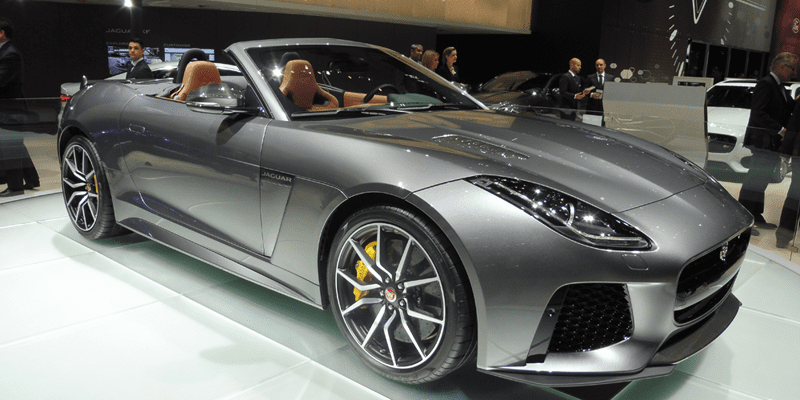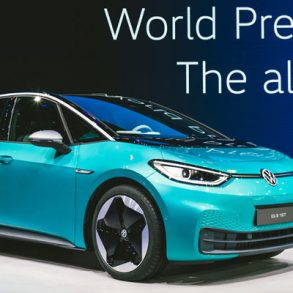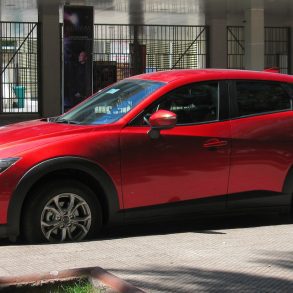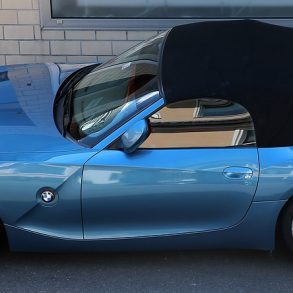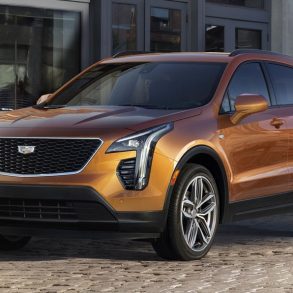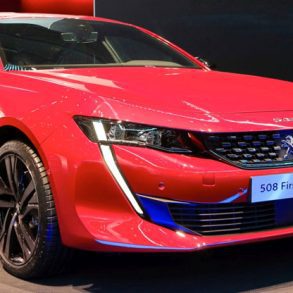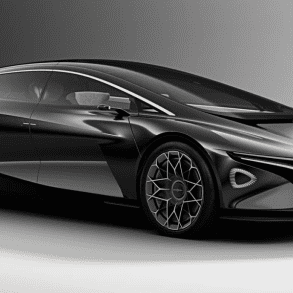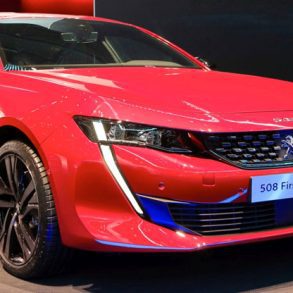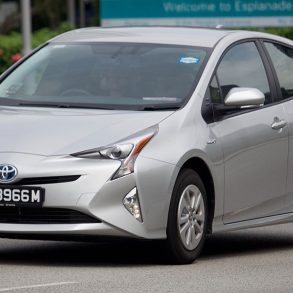-
Abarth 124 Spider
This is the tuned version of the Fiat 124 Spider, which in its turn is based on the fourth generation Mazda MX-5. That means a long hood, low seating position and short but stubby rear end. And of course rear wheel drive and a short-shifting manual gearbox. The Abarth looks more militant than the Fiat thanks to its black hood and trunk lid, but the powerboost of just 10 hp to 170 hp isn’t very impressive and the chassis can handle more power for sure. I hope they’re coming up with more impressive hardware in the future, for example the 300 hp 1,8 liter they’ve mounted in the rally-spec Abarth hard-top. That unit has been mounted further back in the engine bay for better weight distribution. But that’s not all: it looks so stunning you’d wonder why they don’t use a transparent hood to show their jewelry to the world.
-
Alfa Romeo Giulia
We’ve finally seen the mainstream versions of the Alfa Romeo Giulia, after having been teased with the Giulia QV for over six months now, and honestly I hate to say this, but I’m slightly disappointed with them. The Giulia looks absolutely stunning and very aggressive with the QV body kit, and the white one on display wasn’t too bad, but the blue and grey ones just look didn’t do it for me. The lame wheel designs didn’t help and neither did the uninspiring colors. I really hope this is Alfa’s attempt at following Audi’s strategy of making the basic car look so lame that anyone with even one drop of petrolhead-blood in his body is forced to spend extra on the optional sports package (or S-line for Audi) with body kit and a nice set of wheels to make the car look the way it’s supposed to look.
The Giulia will be available in Europe with three 2,2 liter four-cylinder turbodiesel engines, the 150 hp and 180 hp versions are rear-wheel drive only and the option of manual or automatic gearbox. The 210 hp diesel will only have four-wheel drive and an automatic. The 2 liter four-cylinder turbocharged petrol engine will also come in three versions all with standard automatic gearbox. The entry-level version has 200 hp with rear-wheel drive, the 250 hp version has four-wheel drive and the 280 hp version surprisingly comes standard with RWD, but optional AWD. The next step up is the QV with 510 hp, as we already know.
-
Alpina B7 Biturbo
For five generations, BMW hasn’t made an M7 to compete with the S-Class AMG and the Audi S8, leaving a nice opportunity for Alpina to help out those who have a thing for fast and sporty BMWs. Even while BMW is also revealing its M760Li based on the new generation 7-series, Alpina has worked on a new B7 as well, using a tuned version of the familiar 4,4 liter twin-turbo V8 from its donor car, which also powers the Alpina B5 and B6. Alpina has made some tweaks to the air suspension and of course added its typical 20-inch alloy wheels and a subtle body kit, making sure the B7 is easily recognizable as an Alpina instead of a regular BMW. In the B7, the engine develops a staggering 600 hp and 800 Nm of torque, launching the car from 0 to 100 km/h in a mere 3,7 seconds and a top speed of 310 km/h. Impressive figures for a luxury limo! And look at that interior, it’s awesome.
-
Aston Martin DB11
The successor to the DB9 will have a new 5,2 liter twin-turbo V12 engine with 600 hp and although Kriss doesn’t like it that much, I do. It’s still easily recognizable as an Aston Martin and perhaps the design won’t have a long shelf life as Astons usually do, but at least they didn’t come up with yet another slightly different version of the same design. Imagine what would’ve been the criticism if they did that! Sure, the design may not be as coherent as we’re used to from the ever-so-distinguished Brits, but it looks every bit as futuristic as an upper class sports car/GT should. And the interior is truly a piece of art. I just wish they hadn’t stuffed the boot full with that tailor-made baggage, because that what it looks like: stuffed. Not very Aston Martin-like. Ferrari did that better with the GTC4 Lusso.
-
Audi S4 Avant
Is this really big news? Not really, the four-wheel drive S4 Avant has the same specs as the sedan: a 3 liter V6 TFSI petrol engine with 354 hp and 500 Nm of torque. The sprint from 0 to 100 km/h is done in 4,7 seconds and top speed is limited to 250 km/h. If you try hard, you should be able to use as little as 7,4 l/100 km. The big difference from the sedan is the boot of course, which has increased from 480 liters in the sedan to 505-1.510 liters (when you fold the rear seats) in the Avant. The drawback is the extra 45 kilograms of weight of the Avant, at 1.675 kg.
-
Audi Q2
Audi will expand its crossover line-up at the small end with the Q2, which is based on the 2012 Cross Lane Coupe concept. After careful deliberations whether to call it Q1 or Q2, and a legal issue with Alfa Romeo which has used the Q2 moniker for a special version of its GT a few years ago, Audi has settled for the latter which is surprising considering they’re working on a coupe-like version of the car as well, and Audi’s naming strategy for the Q-line was to give the practical versions an odd number and the coupe versions an even number.
The Q2 is built on VW Group’s MQB platform instead on that of the A1 hatchback and will feature three-cylinder and four-cylinder engines. If they’re working on an RS Q2, that might get the five-cylinder engine. Expect the Q2 in showrooms in the fall for a price between that of the A3 hatchback and the Q3 crossover. Audi expects to sell about 70.000 a year of them. Are they going to? Well, honestly I think it’s going to cannibalize on the Q3, but they’re still going to sell a lot of them, just for being an Audi. Like the DB11, Kriss didn’t fancy the design much, and I’m not convinced either. Okay, so it does look less predictable than most of Audi’s recent launches, but it isn’t all that original either. The blacked-out C-pillar is a design trick that’s getting stale now (it’s also on the Renault Megane Estate, but less eyecatching on that model).
-
Audi RS Q3 Performance
Audi is making its RS Q3 redundant with the RS Q3 Performance, which delivers 368 hp and 465 Nm of torque from the 2,5 liter five-cylinder engine, which is similar to the RS3 Sportback. The extra 28 hp and 15 Nm are the result of a reworked radiator and an optimized fuel pump, among others. 0 to 100 km/h shouldn’t take more than 4,4 seconds (faster than the S4 Avant), which is 0,4 seconds faster than the regular RS Q3. Top speed is limited to 270 km/h.
-
BMW M760Li
For the first time ever, BMW is giving its 7-series limousine the M-treatment, for those to whom anything less than 12 cylinders is considered too pedestrian. As the name (not an M7) suggests, the M760Li xDrive is not a full-blown M, but they’ve given it the M-performance label. Still, the 6,6 liter twin-turbo V12 with close to 600 hp and 800 Nm of torque will launch the limo from 0 to 100 km/h in 3,9 seconds and is electronically limited to 305 km/h with the optional M Driver’s Package.
-
Bugatti Chiron
The Chiron is Bugatti’s successor to the Veyron, and it has only one duty: top the Veyron in every aspect. This is a superlative for a supercar: 1.500 hp, 1.600 Nm of torque, limited to 420 km/h because of the tires, but when everything is accounted for and they can find a long enough piece of road, it should easily top the Veyron’s record of 431 km/h. But Bugatti themselves haven’t been able to test it yet and don’t know exactly how fast its goes. Optimistically, they’ve set the speedometer to a maximum of 500. The interior is as sumptuous as you’d expect from something that tailors to the more-money-than-taste crowd, but they’re only building 500 “Special Editions” of them, so each interior will be different than the next one. One third has already been sold before the official introduction, at a minimum price of € 2,4 million before taxes.
-
Citroën SpaceTourer / Peugeot Traveller / Toyota ProAce Verso
The cooperation between PSA and Toyota continues with a new generation commercial vans replacing the Jumpy, Expert and current generation ProAce. I guess the French are also hoping to keep a few faithful Citroën C8 and Peugeot 807 buyers on board with the “MPV” versions which can seat up to 9 people. They’ll be available with diesel engines only, ranging from 115 hp to 180 hp (and 400 Nm of torque). The exterior designs are not as differentiated as the C1/108/Aygo triplets, with just a different nose on each van. I found the interior more utilitarian and less luxurious than the Mercedes-Benz V-Class, but that’s not very surprising as the French-Japanese vans/MPVs are aiming for a different customer with a much different budget.
-
Ferrari GTC4Lusso
The Ferrari FF is replaced by the GTC4 Lusso, which adds four-wheel steering to the four-wheel drive four-seater GT. That four-wheel steering was also used on the F12TdF and works together with Slip Side Control 4.0, integrating the electronic differential and adaptive dampers. Fortunately, Ferrari isn’t going to turbocharge the entire line-up yet, and is staying faithful to the naturally-aspirated 6,3 liter V12 engine, for now. It does get a slight power upgrade to 690 hp and 697 Nm of torque. The 0 to 100 km/h sprint is done in just 3,4 seconds and the top speed is 335 km/h.
The exterior has been reworked as well, with all new sheetmetal making the GTC4 Lusso more sculpted and masculine than the somewhat rounded shape of the FF. The fastback roofline which has been subject to the most criticism has been lowered and a spoiler has been added. The trunklid now has a kink and the single taillights are replaced by a more historically accurate double on each side. In real life it looks very good and it’ll make us forget about the FF in no time. I also liked the tailor-made luggage set in the boot, it looked a better fit than the Aston DB11’s.
-
Fiat Tipo hatchback and SW
The Fiat Tipo sedan only just started European sales the last few months of 2015, but the Italians are already revealing the five-door hatchback and station wagon of their new compact car. Mechanically they’ll be similar to the sedan, which means nothing state-of-the-art, but low-tech and reliable engines and no downsizing. No high-tech gadgets in the interior either, but just functional and practical design. For the Western European market these two new versions will be much more important for the model’s sales volume than the sedan, as the four-door body-style is only popular in the Mediterranean countries and Eastern Europe, so the hatchback and SW will carry the load and should bring Tipo sales into the European sales top-150. The hatchback will be in showrooms just before summer, the station wagon will follow in the fall.
While I think the pair looks pretty handsome, I’m still not sure about the sales potential for a compact segment Fiat. I like the brand’s strategy of going out of sync with the rest of the segment, so they can operate with limited direct competition, but outside of its home market Fiat only really sells the 500 family: of all its non-500 family vehicles sold in Europe, two thirds are sold in Italy.
-
Hyundai IONIQ
The South-Korean brand wants to become a big player in electrified vehicles and is placing its bets on the IONIQ, which will arrive in showrooms this year. Although already revealed in Korea and therefore technically a European premiere, it’s significant enough to be mentioned here. This will be the first car on the market that’s available with three choices of electrified drive trains: hybrid, plug-in hybrid or full electric. The new alternative drive train platform will also be used in the upcoming Niro crossover from sister brand Kia, both will be produced in South Korea. Together with the ix35 Fuel Cell Vehicle, the IONIQ shows how Hyundai is betting on all the horses in the race for future mobility solutions.
The hybrid versions will combine a 1.6 liter petrol engine with a 32 kW electric motor with a combined output of 141 hp and 265 Nm of torque. The EV will have an 88 kW electric motor and a 28 kWh battery under the rear seat to offer a range of 170 km and a top speed of around 150 km/h. The exterior is less revolutionary than the mechanics, but with the new generation Prius in mind that’s not necessarily a bad thing. I actually like the smooth looks of the car, although if find the grey plastic that replaces the grille in the EV less attractive than the chrome bars in the grille of the two hybrid versions. Deliveries of the hybrid will start in the summer, the plug-in hybrid will follow in September, and the EV will arrive in showrooms early 2017.
-
Jaguar F-Type SVR
Jaguar is adding a new version on the top of the food-chain of the F-Type line-up with the 575 hp SVR. That’s another 25 hp on top of the F-Type R and an extra 20 Nm of torque to 700 Nm from the same 5 liter supercharged V8 engine. The SVR needs just 3,7 seconds to reach 100 km/h and the coupe continues to 322 km/h, beating the convertible by a few clicks. The “regular” F-Type R is limited to 300 km/h and takes less than half a second longer for the sprint. For those willing to pay an extra subcompact car on top of the price of the F-Type R, Jaguar will also adjust the suspension, add 20-inch alloy wheels, an active aero pack and a special body kit. In showrooms next summer.
I love the aggressive body kit and rear spoiler on the SVR, but Jaguar loses some sympathy for borrowing a page from Porsche’s playbook in charging an insane premium for a few extra bits and a minor power upgrade. Nonetheless do I expect the SVR to sell like the proverbial hot cakes to those who simply want the fastest, most expensive model in the line-up.
-
Kia Niro
Like the IONIQ not a world premiere, but significant enough to be mentioned here: the Kia Niro hybrid crossover, which will reach showrooms around the end of 2016. The Niro is built on the same alternative drive platform as the Hyundai IONIQ and features the same hybrid power train. In the future, the Niro will be available as a plug-in hybrid as well. Kia aims to achieve CO2 emissions of 89 g/km for the hybrid, and a special feature is the optional hitch which allows it to pull a trailer of up to 1.300 kg. The design is easily recognizable as a modern Kia, and looks more like a hatchback than a true crossover, and I think the cleaner looks are more appealing than the slightly larger Sportage which has those strange quadruple daytime running lights in the front bumper. The Niro’s interior is less exciting than the mechanics or the exterior design, all black and grey, but it’s comfortable and spacious enough. This could give the Kia brand yet another boost in the sales ranking as it enters with a Unique Selling Point in a very popular segment.
-
Kia Optima Sportswagon
One of the main reasons why the Kia Optima has been a laggard in the European midsized car segment is the lack of a station wagon, which its sister model Hyundai i40 did have and which was more popular than the sedan for that model. To show that Kia takes the European market very serious and wants to be a first-tier player, Kia is finally launching a station wagon version called Optima Sportswagon. The name may be a bit ambitious, but it looks sleek and arguably better than the sedan. They’re even launching a 245 hp 2 liter engine in GT trim, exclusively to the Sportswagon. However, the 163 hp 2 liter petrol and a 141 hp, 340 Nm 1,7 liter turbodiesel engine will be the volume sellers. Later on, the SW will also become available with the plug-in hybrid technology of the sedan, giving it a 54 km EV range and a theoretical 37 g/km CO2 emission. Its sleek and sporty looks don’t compromise space, as the Optima SW has a 553 liter boot, larger than the Ford Mondeo (although the Skoda Octavia Combi can carry 610 liters).

